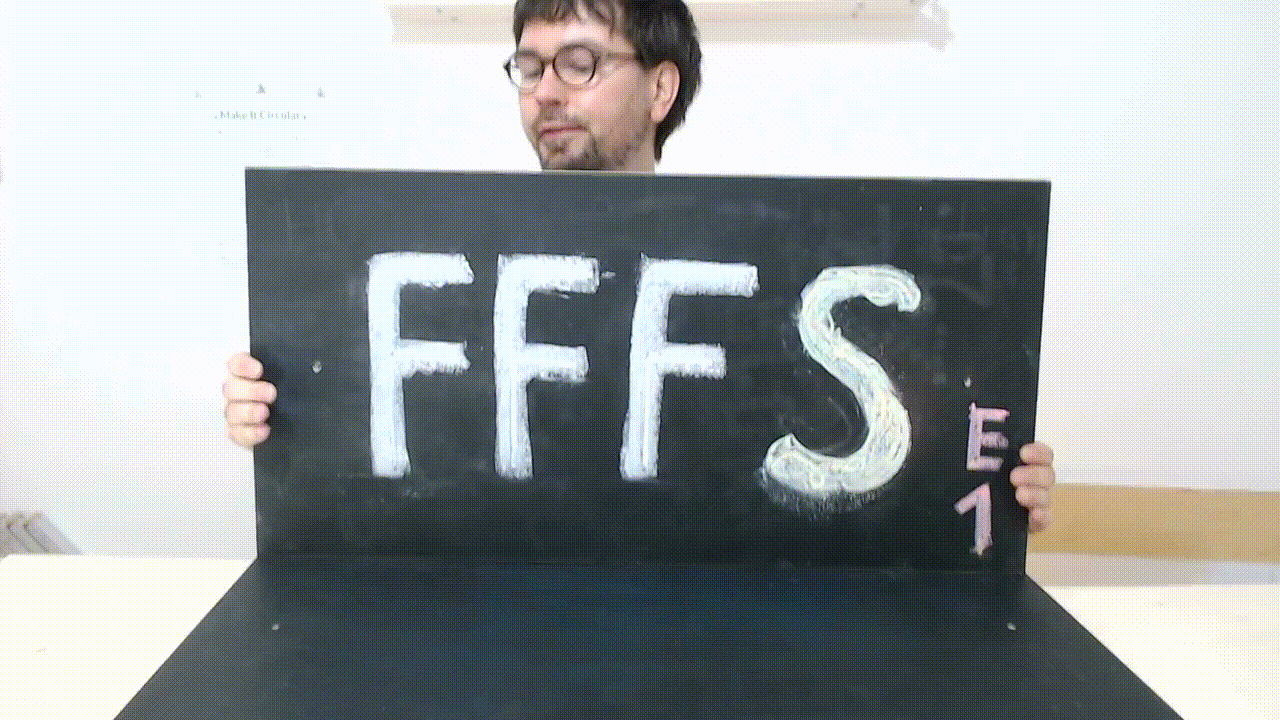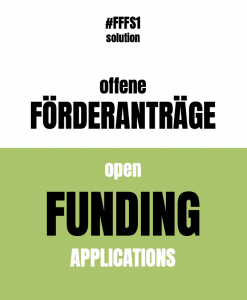FFFS – Fixing Funding For Sustainability – Episode 1: Grants / Förderanträge
/
/ Deutsch unten /
English: Here the first episode of the video series „FFFS – Fixing Funding For Sustainability“ – a video series to improve the funding of global sustainability. This first episode is about grants. If you prefer reading over watching scroll down to the transcript.
What to do with this video?
This is for us. Do you know a funder who does something like this? Maybe you applied somewhere and you experienced something along these lines? Well, let them know. Send them this video. The idea is: Sustainability activists can talk to their funders like „unions to employers“. Let’s be a decentralized union and send this to our funders and push them towards collaborative approaches to funding instead of competitive funding. Let’s together fix the funding of sustainability for more sustainability impact.
Update*: Open Funding Applications are online!
I started to implement the constructive suggestion from the video and created a form for an open funding application as well as a tutorial and … actual open funding applications! Read and use here.
*
DEUTSCH: Hier ist die erste Episode von „FFFS – Fixing Funding For Sustainability“ („Wir reparieren die Finanzierung von Nachhaltigkeit“) – eine Videoserie zur Verbesserung der Nahhaltigkeitsfinanzierung. Die erste Folge dreht sich um Ausschreibungen und Förderanträge. Wer lieber liest als schaut: Unter dem Video ist das vollständige Skript zum Video veröffentlicht (allerdings nur in englischer Sprache).
Was anfangen mit dem Video?
Kennst Du/Sie einen Förderer, der ähnliche Verfahren nutzt? Vielleicht hast Du Dich/haben Sie sich irgendwo beworben und genau diese Erfahrungen gemacht? Gut, dann sende/senden Sie diesem Förderer das Video. Förderer sollten diese Probleme kennen und breiter diskutieren. Die Idee ist, dass Nachhaltigkeitsinitiativen mit ihren Förderern reden wie Gewerkschaften mit Arbeitgebern. Lasst uns eine dezentrale Gewerkschaft sein und diese Ideen und Fragen an unserer Förderer senden und sie zu kollaborativen Förderansätzen bringen und weg von kompetitiven. So können wir gemeinsam die Finanzierung von Nachhaltigkeit verbessern und mehr Nachhaltigkeitsaktivitäten ermöglichen!
Update*: Offene Förderanträge online!
Ich habe mit dem konstruktiven Vorschlag aus dem Video einfach angefangen zu arbeiten und einen Aufruf und eine Anleitung für offene Förderanträge online gestellt und auf Mifactori auch die ersten offenen Förderanträge stehen. Hier geht’s lang: Offene Förderanträge! 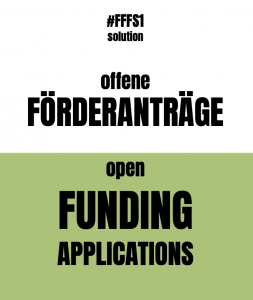
*
Script FFFS 1 – Grants
English: Here are my notes for the video which have some “script” like qualities – although super raw they should deliver the same message and can be shared as text.
Deutsch: Wer lieber liest als Video guckt, findet hier meine Notizen fürs Video. Sie funktionieren praktisch wie ein Skript. Allerdings ist der Text extrem roh und unbearbeitet und nur auf Englisch verfügbar (aus Zeitgründen entwickele ich das Skript in Englisch und übersetze dann spontan, was auch das im Video zeitweise auftretende „Denglisch“ erklärt.)
. . . . . . . . .
SCRIPT
. . . . . . . . .
Hi, my name is Lars Zimmermann. And this is FFFs – Fixing Funding For Sustainability, Episode 1.
– TITELSCHILD –
And today I am going to talk about Grants or similar funding sources for sustainability. Grants you have to apply for – that ask you to send in an application or proposal.
Broken Grants
Let’s look at an example. Very often these grants work like this: An institution has some money and wants to give it to sustainability projects. Let’s say it is 1000 Euros.
– TURM AUS 10 LEGOSTEINEN –
And they make people apply for it. The application is a bit complicated. Let’s say, it takes 4 hours. When we say each hour of work is worth 25 Euros then each application is worth 100 Euros.
– EIN LEGOSTEIN NEBEN DEN TURM –
This is 100 Euro or 4 hours the initiative already has! But instead of using it for real sustainability activities like saving bees, planting trees or do whatever – they use it so create a proposal! It is 4 hours or 100 Euros that are taken out of sustainability, for now.
Grants consider themselves successful when many people apply! And the world of sustainability is full of people, projects and organizations that need money. So in the end let’s say 50 initiatives apply.
This sums up to 5000 Euros!
– 5 TÜRME MIT JEWEILS 10 LEGOSTEINEN –
These 5000 Euros or 200 hours is not money or time that has gone into sustainability. It has not saved birds, challenged pollution, developed new green alternatives. No, it was used to write about what should be done instead of doing it.
Write about what should be done instead of doing it.
And then one initiative gets the grant. So 1000 Euro go into sustainability!
But in exchange 5000 EUR go out of sustainability!
– LEGOTÜRME WECHSELN DIE SEITEN –
So we have a final result of – minus 4000 Euro for sustainability. 4000 Euro that are burned! Our grant – that might actually wanted to support sustainability – actually had negative impact. It effectively took out energy out of sustainability, slowed it down.
I have seen this so often. Even with numbers crazy as these.
This is broken. Right?
. . .
Let’s have a closer look: WHAT is broken, WHY is it broken. And how to fix it.
Excursus: Cost Externalization
This dynamic is a case of externalization. Externalization of costs! Externalization is a classical problem especially for sustainability!
Let’s do a quick excursus on externalization!
– SZENENWECHSEL: Lego Fabrik, Tafel, Dorf –
Let’s do a quick excursus on externalization. A simple explanation.
Externalization means: When you produce a product there are costs attached to make it like materials, energy, work. You have to pay something before you can profit from selling the finished product.
Externalization means that you make others pay these costs! Wherever you can.
Here is a classical example: Imagine a factory in the woods. It produces a good. And on by-product is polluted toxic water. It is expensive to clean the water or hire someone for it. So instead of paying this the factory releases the toxic water quietly into the river. Problem solved, money saved.
And there is a little village along the river. And the toxic water makes the people there sick. They have to stay at home and rest in bed. Instead of going to work an make bread or whatever there body is busy dealing with the toxins. Also they need expensive medication. Now there bodies become the filter for the water! They become the filter mechanism!
These costs for their time and the medication are costs attached to making the product. But not the factory is paying these costs. But the people here in the village. The factory has externalized the costs to the village.
They pay. The factory only benefits!
– SZENENWECHSEL: WIEDER ZURÜCK –
This is what we do, when we pollute and exploit the planet. Others pay. Or will pay. For example future generations. Or you at a later date.
“Evil” capitalistic companies are great at externalizing costs in order to maximize profit. And this is why we need sustainability after all! Dealing with and cleaning up after externalizations is maybe the major reason for sustainability.
And here we have grants that want to do something for sustainability and they use the very same mechanism! Contradicting their mission.
(((I mean, if we have a process like that in the world of startups for example – no problem. Let’s filter them out. Who cares if we have more products? But sustainability? I think there we can take anything!!! Or almost anything! We don’t need ONE bee initiative. We can have one in every village. Use the exact same mechanism – externalization – to deal with effects of externalization?)))
How so? /
Before we come to ideas how to make this better let’s first understand what is the issue here – what is the problem.
Bad & Better Filters
What is their – the grant givers – problem?
They have money and they want to give it to someone who is doing relevant things. How to find and identify this someone? They need to find and filter! But this – finding and filtering – comes with costs. If you look for something specific. You need to do research.
And this mechanism here externalizes these costs to the initiatives. They have to write a proposal. And present themselves according to the questions the grant has. All of them.
– AUF DIE LEGOTÜRME AUS SZENE 1 ZEIGEN –
They spend all the time to pack something up – customized for the specific unique request of grant – and the grant giver can cherry pick.
This is absurd high costs for giving away 1000 Euros. Paid by them – the initiatives. Not them – the grant givers. They (the grant giver) benefits – “aren’t we cool! We give/gave money to sustainability!” – and one of the initiatives benefit. But all the other 49 initiatives paid for it! And in the end it is planet earth!
Media = Organization = Collaboration
WHY is this so? Why are many or the majority of the grants are doing this?
Well, there is a good explanation for this. It used to be the best way – in the world before the internet. How?
Let’s say you are an institution.
– EIN GROSSER DUPLOTURM UMRUNDET VON VIELEN KLEINEN EINZELLEGOSTEINEN –
In a world without internet? How should you learn about all the small initiatives? They can’t buy adds in newspapers or print 1 Million postcards and send them around or buy or air time on TV or radio.
So you buy this airtime once and become visible to all the initiatives – and they send single (and therefore cheap) letters to make themselves visible.
So in that days you asked THEM to send things TO YOU. From the periphery to the center. This was the cheapest way for all.
– ZEIGE VON DEN KLEINEN STEINEN AUF DEN GROSSEN –
But the world has changed! We have now the internet. And let’s say since at least 2010 it is ridiculous quick, cheap and easy to set up a website! In less than a day. So the small initiatives can all set up websites. And make themselves visible to the world. Permanently.
And then the institution can do the work. Use a search engine! And find them.
– ZEIGS –
Of course. You might ask: All these websites, they look so different. And many of them are really low in quality! Some of them have barely information on them. The websites don’t help to make a decision.
It could work like this:
The institutions posts about a grant and announces that it will browse the web for websites of initiatives looking for this, this, this and that information on a website. “Please post it under ‘About’”. This is the structured proposal! Instead of sending it to us post it on the web. And here are some suggestions how to set up a simple website quick and cheap.
This would already do something good. Because many initiatives have websites that don’t explain well what they do because they are busy explaining it in hidden grant applications instead. So you help them to set up a good and useful website!
This creates the benefit that they can use this website also for others things. It is easier for the public to see what is happening here and also – and here comes the beauty – also for other grant givers.
– ZEIGE DAS MIT MEHREREN DUPLO TÜRMEN –
Let’s say you are a big and really influential grant giver or group of grant givers. You could create some kind of open standard! For information provided about an initiative. Create a way better ecosystem of visibility! And everyone can build on it. Plug into it. An open standard – like a CV or example.
Inquiries
And then you find one you like. And of course you have additional questions. You need to know more specific things.
And then you ask these few initiatives to write a more detailed proposal for you. But you give them already a little bit of money for that! You pay them to do this!
This is how you internalize the filter costs. And don’t exploit people that want to create a sustainable planet. You money goes 100% into accelerating change and not to a significant portion into destroying change.
There are a few grants that work a bit like this. But why not way more!
More Ideas!
Ok. If you reflect a while on this you will find a lot of interesting angles, further questions and from that extra ideas on top.
For example an open database or list where every initiative that has set up a website can add themselves. So the institutions don’t even have to browse the web. But can go straight to that list.
Imagine what kind of sustainability dynamic this could unfold.
With Openness (in the form of an open information standard and open available information) and smart use of the internet we can make things a lot better.
End
Well, this was FFFS – Fixing Funding For Sustainability Part 1.
Stay tuned for more broken things and ideas how to fix them.
My name is Lars Zimmermann and I have a bunch of cool projects you can check here:
– ABSCHLUSSBOARD BLOGLZ.DE –
Bloglz.de
Blog Lars Zimmermann d e.
–––
(Missing I really wanted to add that some grant givers even ask for Videos or Pitches – sometimes even in special formats like Pecha Kucha – which increased the costs of the application dramatically and there for takes even more time out of change making. /// If you like conspiracy theories you could argue that some of these grants are actually on a secret mission: taking out energy of/slowing down sustainability progress.)
–
Discussion
from Facebook:
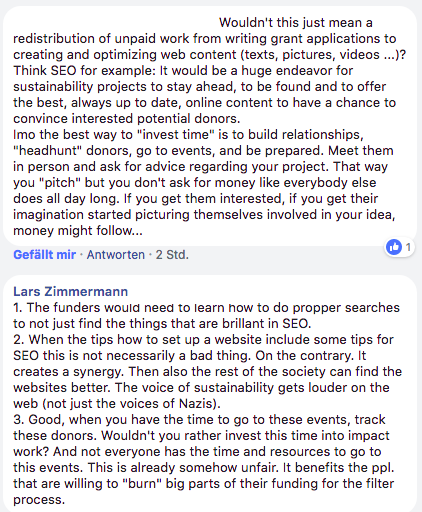
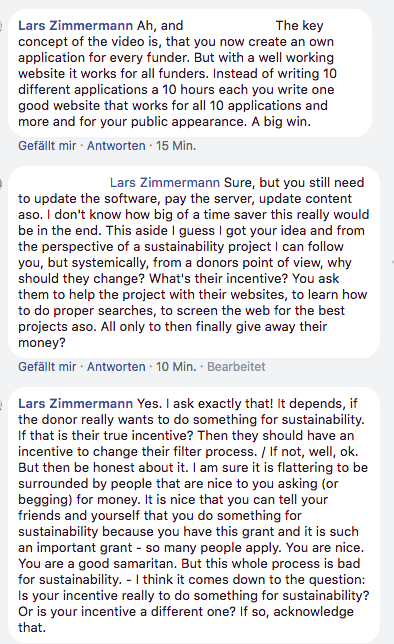

–
More Fixing Funding For Sustainability
More Episodes of: „FFFS – FIXING FUNDING FOR SUSTAINABILITY“
–
Donate
Liked the video/post? Please support the author.
